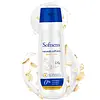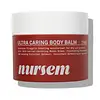What's inside
What's inside
 Key Ingredients
Key Ingredients

 Benefits
Benefits

 Concerns
Concerns

 Ingredients Side-by-side
Ingredients Side-by-side

Water
Skin ConditioningCetearyl Alcohol
EmollientIsopropyl Myristate
EmollientCeteareth-22
EmulsifyingCaprylic/Capric Glycerides
EmollientTribehenin
EmollientGlycol Stearate
EmollientParaffinum Liquidum
EmollientXylitylglucoside
HumectantAnhydroxylitol
HumectantXylitol
HumectantCyclopentasiloxane
EmollientParfum
MaskingSodium Benzoate
MaskingPhenoxyethanol
PreservativeAminomethyl Propanol
BufferingDisodium EDTA
Avena Sativa Kernel Flour
AbrasiveMilk
Skin ConditioningCream
EmollientAcrylates Copolymer
Niacinamide
SmoothingCalcium Pantothenate
Sodium Ascorbyl Phosphate
AntioxidantTocopheryl Acetate
AntioxidantPyridoxine Hcl
Skin ConditioningMaltodextrin
AbsorbentSodium Starch Octenylsuccinate
AbsorbentSilica
AbrasiveWater, Cetearyl Alcohol, Isopropyl Myristate, Ceteareth-22, Caprylic/Capric Glycerides, Tribehenin, Glycol Stearate, Paraffinum Liquidum, Xylitylglucoside, Anhydroxylitol, Xylitol, Cyclopentasiloxane, Parfum, Sodium Benzoate, Phenoxyethanol, Aminomethyl Propanol, Disodium EDTA, Avena Sativa Kernel Flour, Milk, Cream, Acrylates Copolymer, Niacinamide, Calcium Pantothenate, Sodium Ascorbyl Phosphate, Tocopheryl Acetate, Pyridoxine Hcl, Maltodextrin, Sodium Starch Octenylsuccinate, Silica
Water
Skin ConditioningButyrospermum Parkii Butter
Skin ConditioningGlycerin
HumectantTheobroma Cacao Seed Butter
EmollientCaprylic/Capric Triglyceride
MaskingAvena Sativa Kernel Flour
AbrasiveMyristyl Lactate
EmollientNiacinamide
SmoothingPanthenol
Skin ConditioningCetearyl Alcohol
EmollientAllantoin
Skin ConditioningTriheptanoin
Skin ConditioningHelianthus Annuus Seed Wax
Skin ConditioningC13-16 Isoalkane
SolventGlyceryl Stearate
EmollientJojoba Esters
EmollientStearic Acid
CleansingOphiopogon Japonicus Root Extract
Skin ConditioningChondrus Crispus
MaskingSodium Benzoate
MaskingCitric Acid
BufferingXanthan Gum
EmulsifyingSodium Stearoyl Glutamate
CleansingPotassium Sorbate
PreservativeTetrasodium Glutamate Diacetate
Maltodextrin
AbsorbentTocopheryl Acetate
AntioxidantPolyglycerin-3
HumectantWater, Butyrospermum Parkii Butter, Glycerin, Theobroma Cacao Seed Butter, Caprylic/Capric Triglyceride, Avena Sativa Kernel Flour, Myristyl Lactate, Niacinamide, Panthenol, Cetearyl Alcohol, Allantoin, Triheptanoin, Helianthus Annuus Seed Wax, C13-16 Isoalkane, Glyceryl Stearate, Jojoba Esters, Stearic Acid, Ophiopogon Japonicus Root Extract, Chondrus Crispus, Sodium Benzoate, Citric Acid, Xanthan Gum, Sodium Stearoyl Glutamate, Potassium Sorbate, Tetrasodium Glutamate Diacetate, Maltodextrin, Tocopheryl Acetate, Polyglycerin-3
Ingredients Explained
These ingredients are found in both products.
Ingredients higher up in an ingredient list are typically present in a larger amount.
Oatmeal flour is created by grinding down the kernels of oats. Oatmeal helps sooth, hydrate, and protect the skin.
Oatmeal kernel flour has abrasive, or exfoliating, properties.
Learn all about the skin benefits of colloidal oatmeal here.
Learn more about Avena Sativa Kernel FlourCetearyl alcohol is a mixture of two fatty alcohols: cetyl alcohol and stearyl alcohol. It is mainly used as an emulsifier. Emulsifiers help prevent the separation of oils and products. Due to its composition, it can also be used to thicken a product or help create foam.
Cetearyl alcohol is an emollient. Emollients help soothe and hydrate the skin by trapping moisture.
Studies show Cetearyl alcohol is non-toxic and non-irritating. The FDA allows products labeled "alcohol-free" to have fatty alcohols.
This ingredient is usually derived from plant oils such as palm, vegetable, or coconut oils. There is debate on whether this ingredient will cause acne.
Due to the fatty acid base, this ingredient may not be Malassezia folliculitis safe.
Learn more about Cetearyl AlcoholMaltodextrin is a polysaccharide. It is derived from starch such as rice, corn, wheat, or potato starch.
In food, Maltodextrin is used to improve the texture and thicken a product. Due to its structure, it can help create a gel texture. As an emulsion stabilizer, it helps keep the ingredients in a product together.
As a polysaccharide, Maltodextrin has moisturizing properties. Polysaccharides are a type of carbohydrate. The top layer of skin uses polysaccharides to retain water, keeping the skin hydrated.
Maltodextrin is water soluble and has a sweet taste.
Learn more about MaltodextrinNiacinamide is a multitasking form of vitamin B3 that strengthens the skin barrier, reduces pores and dark spots, regulates oil, and improves signs of aging.
And the best part? It's gentle and well-tolerated by most skin types, including sensitive and reactive skin.
You might have heard of "niacin flush", or the reddening of skin that causes itchiness. Niacinamide has not been found to cause this.
In very rare cases, some individuals may not be able to tolerate niacinamide at all or experience an allergic reaction to it.
If you are experiencing flaking, irritation, and dryness with this ingredient, be sure to double check all your products as this ingredient can be found in all categories of skincare.
When incorporating niacinamide into your routine, look out for concentration amounts. Typically, 5% niacinamide provides benefits such as fading dark spots. However, if you have sensitive skin, it is better to begin with a smaller concentration.
When you apply niacinamide to your skin, your body converts it into nicotinamide adenine dinucleotide (NAD). NAD is an essential coenzyme that is already found in your cells as "fuel" and powers countless biological processes.
In your skin, NAD helps repair cell damage, produce new healthy cells, support collagen production, strengthen the skin barrier, and fight environmental stressors (like UV and pollution).
Our natural NAD levels start to decline with age, leading to slower skin repair, visible aging, and a weaker skin barrier. By providing your skin niacinamide, you're recharging your skin's NAD levels. This leads to stronger, healthier, and younger looking skin.
Another name for vitamin B3 is nicotinamide. This vitamin is water-soluble and our bodies don't store it. We obtain Vitamin B3 from either food or skincare. Meat, fish, wheat, yeast, and leafy greens contain vitamin B3.
The type of niacinamide used in skincare is synthetically created.
Learn more about NiacinamideSodium Benzoate is a preservative. It's used in both cosmetic and food products to inhibit the growth of mold and bacteria. It is typically produced synthetically.
Both the US FDA and EU Health Committee have approved the use of sodium benzoate. In the US, levels of 0.1% (of the total product) are allowed.
Sodium benzoate works as a preservative by inhibiting the growth of bacteria inside of cells. It prevents the cell from fermenting a type of sugar using an enzyme called phosphofructokinase.
It is the salt of benzoic acid. Foods containing sodium benzoate include soda, salad dressings, condiments, fruit juices, wines, and snack foods.
Studies for using ascorbic acid and sodium benzoate in cosmetics are lacking, especially in skincare routines with multiple steps.
We always recommend speaking with a professional, such as a dermatologist, if you have any concerns.
Learn more about Sodium BenzoateTocopheryl Acetate is AKA Vitamin E. It is an antioxidant and protects your skin from free radicals. Free radicals damage the skin by breaking down collagen.
One study found using Tocopheryl Acetate with Vitamin C decreased the number of sunburned cells.
Tocopheryl Acetate is commonly found in both skincare and dietary supplements.
Learn more about Tocopheryl AcetateWater. It's the most common cosmetic ingredient of all. You'll usually see it at the top of ingredient lists, meaning that it makes up the largest part of the product.
So why is it so popular? Water most often acts as a solvent - this means that it helps dissolve other ingredients into the formulation.
You'll also recognize water as that liquid we all need to stay alive. If you see this, drink a glass of water. Stay hydrated!
Learn more about Water